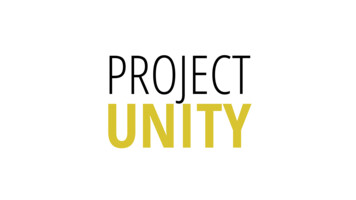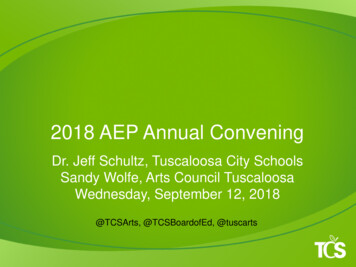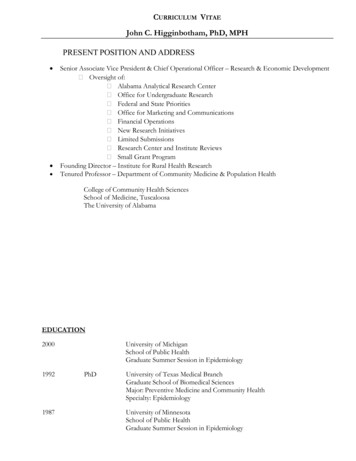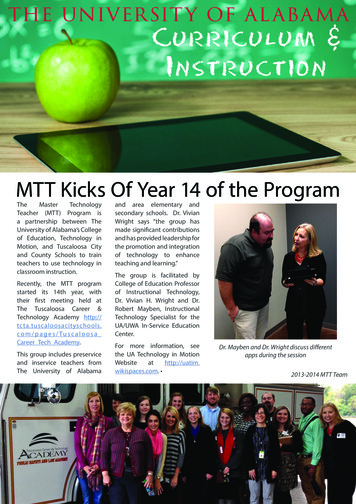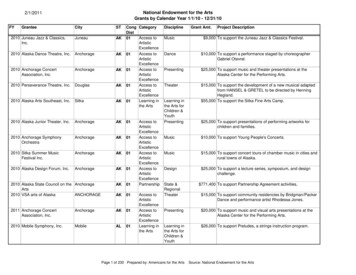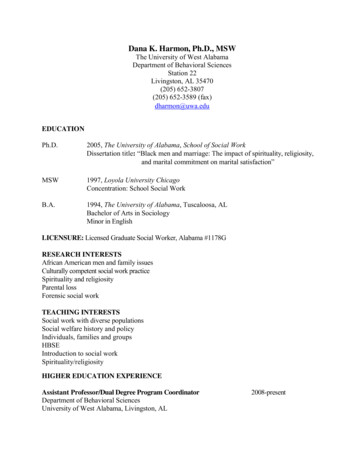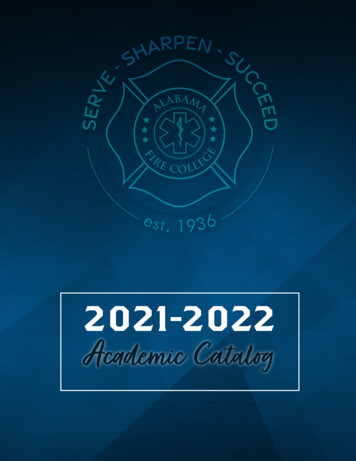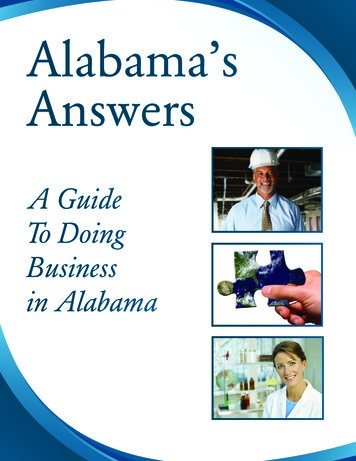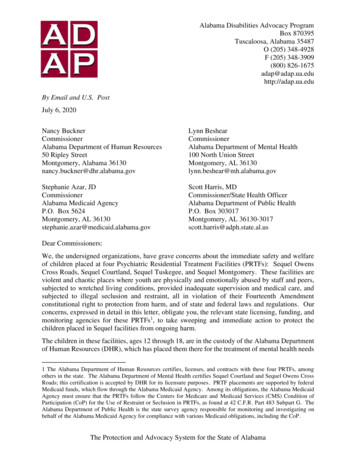
Transcription
Alabama Disabilities Advocacy ProgramBox 870395Tuscaloosa, Alabama 35487O (205) 348-4928F (205) 348-3909(800) 826-1675adap@adap.ua.eduhttp://adap.ua.eduBy Email and U.S. PostJuly 6, 2020Nancy BucknerCommissionerAlabama Department of Human Resources50 Ripley StreetMontgomery, Alabama 36130nancy.buckner@dhr.alabama.govLynn BeshearCommissionerAlabama Department of Mental Health100 North Union StreetMontgomery, AL 36130lynn.beshear@mh.alabama.govStephanie Azar, JDCommissionerAlabama Medicaid AgencyP.O. Box 5624Montgomery, AL 36130stephanie.azar@medicaid.alabama.govScott Harris, MDCommissioner/State Health OfficerAlabama Department of Public HealthP.O. Box 303017Montgomery, AL 36130-3017scott.harris@adph.state.al.usDear Commissioners:We, the undersigned organizations, have grave concerns about the immediate safety and welfareof children placed at four Psychiatric Residential Treatment Facilities (PRTFs): Sequel OwensCross Roads, Sequel Courtland, Sequel Tuskegee, and Sequel Montgomery. These facilities areviolent and chaotic places where youth are physically and emotionally abused by staff and peers,subjected to wretched living conditions, provided inadequate supervision and medical care, andsubjected to illegal seclusion and restraint, all in violation of their Fourteenth Amendmentconstitutional right to protection from harm, and of state and federal laws and regulations. Ourconcerns, expressed in detail in this letter, obligate you, the relevant state licensing, funding, andmonitoring agencies for these PRTFs1, to take sweeping and immediate action to protect thechildren placed in Sequel facilities from ongoing harm.The children in these facilities, ages 12 through 18, are in the custody of the Alabama Departmentof Human Resources (DHR), which has placed them there for the treatment of mental health needs1 The Alabama Department of Human Resources certifies, licenses, and contracts with these four PRTFs, amongothers in the state. The Alabama Department of Mental Health certifies Sequel Courtland and Sequel Owens CrossRoads; this certification is accepted by DHR for its licensure purposes. PRTF placements are supported by federalMedicaid funds, which flow through the Alabama Medicaid Agency. Among its obligations, the Alabama MedicaidAgency must ensure that the PRTFs follow the Centers for Medicare and Medicaid Services (CMS) Condition ofParticipation (CoP) for the Use of Restraint or Seclusion in PRTFs, as found at 42 C.F.R. Part 483 Subpart G. TheAlabama Department of Public Health is the state survey agency responsible for monitoring and investigating onbehalf of the Alabama Medicaid Agency for compliance with various Medicaid obligations, including the CoP.The Protection and Advocacy System for the State of Alabama
2that allegedly cannot be met in the community.2 Sequel Owens Cross Roads (OCR) and SequelMontgomery (Montgomery) both serve girls. Sequel Courtland (Courtland) and Sequel Tuskegee(Tuskegee) are facilities for boys. The youth in facilities like these in Alabama aredisproportionately Black -- data shows that whereas older African American children make up29% of the population in Alabama, they make up 33.8% of the foster care population, and 41.8%of the older youth population in youth facilities.Sequel operates youth facilities throughout the country.3 The company recently made nationalheadlines following the killing of a child, Cornelius Frederick, by staff in a Sequel facility inMichigan.4 Three Sequel employees were criminally charged, and the state has recommended thatits license be revoked. Sequel facilities in Alabama have their own troubled history. In 2017, anemployee at its Three Springs detention facility in Madison was accused of having sexual contactwith residents.5 In 2019, the same facility was forced to close following a rash of security breaches,resulting in multiple instances of residents running away.6 Notably, following these troublingincidents, no state monitoring agency revoked the facility’s license; rather, it closed when the localcity council revoked its business license in response to community uproar and multiple failedattempts by Sequel to fix lapses in security.7 Also in 2019, OCR suffered a rash of residentelopements; the local police chief reported that most of the girls just “walked out” due to a lack ofsecurity.8Despite the national and local spotlight on Sequel’s repeated failures to ensure the safety of youthin its care, Alabama continues to fund, license, and place vulnerable foster youth, already survivorsof abuse and neglect, at these unsafe and countertherapeutic facilities where they are retraumatized. Alabama cannot wait for the death of a child before severing ties with Sequel.Instead, it must immediately end its contracts with Sequel facilities, revoke their licenses andfunding, and relocate each child placed in them to safe and more appropriate care based on eachchild’s individual needs.2 While this letter specifically addresses only the conditions at the Sequel units designated at these sites as PRTFs,two of the facilities, Sequel OCR and Sequel Tuskegee, also have units operated under contract with the AlabamaDepartment of Youth Services (DYS) to house children placed into DYS custody by a juvenile court. There is noreason to believe that those units are not just as problematic and dangerous as the ones contracted by DHR. We urgeDYS and the other relevant state agencies to immediately investigate those units.3 Sequel Youth and Family Services, LLC, is the sole owner and managing member of Sequel Holdings, LLC, whichin turn is the sole owner and managing member of Sequel TSI of Alabama, LLC. Sequel TSI of Alabama, LLCdirectly owns and operates the four Sequel facilities at issue in this letter, which the company identifies by theirgeographic location in the state.4 Cornelius Frederick, a Black sixteen-year-old child at a Sequel facility in Michigan, died of asphyxiation after threeSequel staff members sat on his chest and abdomen for nearly ten minutes while he cried that he could not breathe.See Christine Hauser & Michael Levenson, Three Charged in Death of Michigan Teenager Restrained at YouthAcademy, N.Y. Times (June 24, 2020), https://nyti.ms/3g6ZrzX; see also 3 Charged with Manslaughter for Death ofTeen at Kalamazoo Youth Home, 13 On Your Side (June 24, 2020, 6:24 PM), https://bit.ly/2ZkIdbB.5 Ashley Remkus, Former Troubled Youth Counselor Indicted on Student Sex Charges, AL.COM (Apr. 18, 2018),https://bit.ly/3dGGgvc.6 Ashley Remkus, In the Wake of Killing and Escapes, Madison Revokes Three Springs Business License, AL.COM(Aug. 14, 2019), https://bit.ly/2NzcePm.7 Id.8 Chris Joseph, Sequel: 7 Escapees from Owens Cross Roads Facility in Last 18 Months, WAFF48 (AUG. 18, 2019,6:39 PM), ens-cross-roads-facility-last-months/.
3The Alabama Disabilities Advocacy Program (ADAP), one of the signatories to this letter, isAlabama’s federally funded Protection and Advocacy system, authorized under federal law toprotect and promote the safety and rights of Alabamians with disabilities, including children withmental illness.9 This authority provides ADAP access to public and private facilities in Alabamathat provide care or treatment to such individuals to monitor compliance with respect to safety andrights. The observations and statements reported on in this letter stem from work undertaken byADAP over approximately the last six months pursuant to this federal authority. Multiple ADAPstaff conducted in-depth interviews with almost one hundred residents from the four Sequelfacilities in Alabama. At the same time, ADAP staff visited each facility, documenting theirconditions and culture, including as detailed in the attached report of its monitoring at Courtland.10“I Don’t Feel Safe Here.”This simple statement, voiced repeatedly by Sequel Courtland residents, together with thedisturbing facts described below, evidence Sequel’s failure to protect vulnerable foster youth fromboth physical and emotional harm. Under the Fourteenth Amendment, children in the custody ofthe State have the right to an environment that protects their physical, mental, and emotional safetyand well-being; the right to necessary treatment and care; and the right to adequate supervisionand monitoring of their safety and well-being. These children should be able to sleep securely atnight and thrive during the day, in environments that respect their dignity and personhood.11Instead, abused and neglected foster children placed at Sequel, many of whom have long historiesof damaging placement instability within DHR’s child welfare system, are re-traumatized dailydue to the unsafe and abusive conditions described below.Physical Abuse and Unlawful Restraints: “I can’t breathe.”Under federal law, a child in a PRTF has “the right to be free from restraint or seclusion, of anyform, used as a means of coercion, discipline, convenience, or retaliation.”12 Any restraint of achild must be used only to ensure the safety of the resident or others during an emergency safetysituation and must not result in harm or injury.13 As an emergency safety intervention, restraintsmust “be performed in a manner that is safe, proportionate, and appropriate to the severity of thebehavior, and the resident's chronological and developmental age; size; gender; physical, medical,and psychiatric condition; and personal history (including any history of physical or sexualabuse).”14 DHR’s Minimum Standards for Residential Child-Care Facilities (Minimum9 See Protection and Advocacy for Individuals with Developmental Disabilities Act (PADD Act) and its implementingregulations at 42 U.S.C. §§15041 et seq., 45 C.F.R. §1386 et seq.; Protection and Advocacy for Individuals withMental Illness Act (PAIMI Act) and its implementing regulations, 42 U.S.C. §10801 et seq., 42 C.F.R. §51 et seq.;and Protection and Advocacy of Individual Rights Act (PAIR Act), 29 U.S.C. §§794e, et seq., 34 C.F.R. §381.10 See Letter from Andrea Fannin, Case Advocate Fellow, Ala. Disability Advocacy Program, and Christy Johnson,Investigation Supervisor, Ala. Disability Advocacy Program, to Jason Scrivner, Exec. Dir., Sequel Courtland (July 2,2020), [hereinafter Courtland Report] (appended as Attachment A).11 See, e.g., Ala. Admin. Code §660-5-49-.03(1)(a)(1)(iv) (2003) (providing that behavior management must beadministered in a manner which “assists in establishing safety and emotional well-being for the child, offers ways forthe child to gain control and have needs met without risk to personal safety or the safety of others, and demonstratesrespect for the child as a person of worth and value”).12 42 C.F.R. §483.356(a)(1). This, and other federal requirements regarding the use of restraint and seclusion inPRTFs, are mandated by the CoP, found at 42 C.F.R. Part 483 Subpart G.13 Id. at (a)(1)(3).14 Id. at (b).
4Standards)15 prohibit facilities from using physical abuse and “harsh and humiliating punishment,including corporal punishment.”16Despite these federal and state prohibitions, Sequel engages in a pattern and practice of usingviolent force against children. During ADAP’s in-depth interviews, residents described Sequelstaff slamming residents against walls, punching and slapping residents in the face, usingchokeholds, and laying on top of residents who are lying face down on the ground. Staff violenceagainst youth has resulted in serious injuries, including head trauma, lacerations, hematomas, andloss of consciousness, not to mention trauma to their mental well-being.During interviews with girls at OCR, ADAP learned of multiple incidents of physical aggressionby staff: A girl was ordered by staff to sleep in the hallway. When she refused, she was forcibly draggedout of her room, thrown on the floor and then up against a wall, suffering injuries to her head.Male staff repeatedly enter girls’ bedrooms and put them in violent containments. Since thereare no security cameras in bedrooms, one of the girls with whom ADAP spoke said staff “waituntil off-camera and then restrain them however they want.”One OCR resident was lying by herself on her bed when a male staff member yanked her upoff the bed, threw her onto the ground, and laid on top of her back.A male staff found a girl hiding in her closet. When asked to get down, she did. Staff thentold her she would have to sleep in the common area, which she refused. Staff then forced herout of the room and, when she resisted, staff body slammed her to the floor. Staff attemptedto stop her from spitting by squeezing her jaws, causing severe bruising.A girl was forced against a wall for making a comment to a staff member. After she attemptedto defend herself, the staff member picked her up, slammed her onto the ground, and placedhis weight on her by putting his knee into her back, causing significant pain and troublebreathing. Though the girl complained that she could not breathe, the staff member did notrelent until forced off her back by other staff.Interviews with boys at Courtland revealed similar instances of violence, including in their livingquarters, away from common area cameras: Today, two ADAP attorneys interviewed a resident of Courtland who reported that he hadrecently eloped with several other residents. They were quickly apprehended by communitypolice, and Courtland staff went to pick them up where they had been found. After the policeleft, and before they returned to the facility, one staff beat the resident ADAP staff interviewed,hitting him repeatedly in the face, back, stomach, chest and leg. The resident suffered bruisingto his eyes as a result, which ADAP attorneys observed on the video call.Courtland staff kicked open a boy’s bedroom door and punched the boy in the face after a backand forth door slamming match.Staff threw a boy down on the floor and pulled his arms around his neck, cutting off his abilityto breathe.15 Ala. Admin. Code §660-5-37.16 Ala. Admin. Code §660-5-37-.04(9). See also Ala. Admin. Code §660-5-49-.03(2)(a)(1.) (prohibiting physicaland corporal punishment).
5 One boy suffered chest pain for days after a staff member tackled him to the floor, hurting hisribs. He told the nurse about the pain and that he was having trouble breathing for 2-3 daysfollowing the incident. He was given an ice pack, had his heart rate checked, and was told thathe would have trouble breathing for a while.Another resident suffered headaches after being slammed to the ground by staff, but was notallowed to see medical personnel.A youth reported witnessing a staff member lifting another resident up by the throat andslamming him to the floor.Staff have slapped residents in the face while telling them to calm down.One boy interviewed by ADAP staff had visible injuries to his head. When asked whathappened, the boy said that staff slammed him against a wall the previous night.17A boy said he had seen too many injuries to recall them, all from restraints, such as black eyes,a knot on the head, a broken hand, and a broken foot.18Time-Out and Seclusion: “I had to pee in the corner.”Federal law mandates that seclusion19 never be used as punishment, that it be limited to no longerthan the duration of any emergency safety situation and, under no circumstance, may it exceed twohours for residents ages 9 to 17.20 Federal law requires that clinical staff, trained in the use ofemergency safety interventions, be physically present in or immediately outside the seclusionroom, continually assessing, monitoring, and evaluating the physical and psychological well-beingof the resident in seclusion. A room used for seclusion must allow staff full view of the residentin all areas of the room and be free of potentially hazardous conditions such as unprotected lightfixtures and electrical outlets.21 The unlocked isolation22 of a youth, according to DHR’s MinimumStandards, must be temporary, always under adult supervision, with provisions made for humaneand safe conditions.23 Observations of a child must occur at least every 30 minutes, or more oftenif necessary.OCR, like many facilities, provides a “time-out” room, which is a small room where a resident,upon request, can take a few minutes to calm down and reflect after a stressful event. But, inreality, Sequel has a practice of forcing residents to stay in this room for extended periods of time,and in some cases overnight – using what is nominally a timeout room inhumanely as a seclusionroom. In interviews with ADAP, one resident reported she was kept in the room for over fivehours. Another reported being forced to stay in the room for five days. Yet another girl reportedbeing forced to take her thin plastic bed pad and place it in the otherwise barren room and sleepon the floor for four weeks. OCR staff who are present do not adequately supervise residents,17 Courtland Report, supra note 10, at 2.18 Id.19 Seclusion is the involuntary confinement of a resident alone in a room or an area from which the resident isphysically prevented from leaving. 42 C.F.R. §483.352(3). See also Ala. Admin. Code §660-5-49-.02(2)(s).20 42 C.F.R. §483.358(e)(1).21 42 C.F.R. §483.364.22 Isolation is the placement of a child in an unlocked room for a time-limited period including isolation of a child inan unlocked room other than the child’s own room, isolation of a child age 10 or over in his or her own room for morethan two hours, and repeated confinement of a child in his or her room or any other room (including time-out) thatsubjects the child to lengthy social isolation. Ala. Admin. Code §660-5-49-.02(2)(j). See also 42 C.F.R. §483.368(describing time-out as analogous to isolation).23 Ala. Admin. Code §660-5-49-.04(1)(a)(1).
6leading to opportunities for the girls to self-injure, including by cutting with items like glass shards.It appears that Sequel is using the timeout room for punishment or convenience, both of which areunlawful under federal and state law. Youth report that the room lock is removed when ADAPcomes on site and replaced as soon as ADAP leaves.At Sequel Tuskegee, residents are, at times, locked in the “time-out room” for as many as 72 hours,in direct violation of both state and federal law. A child spending the night in the seclusion roommust drag his mat into the room and sleep on the floor (Tuskegee residents, like those at Courtland,are not provided mattresses but, rather, thin mats which are placed on prison-like concrete orwooden bed frames.24) The seclusion room has no toilet or sink, forcing the residents to bang onthe door in order to get the staff’s attention to use the restroom. When they cannot get staffmembers’ attention, the boys are forced to urinate in the corner of the room and clean it up later orurinate into a container, if they have one. Staff do not provide adequate monitoring or supervision.In one instance, in utter desperation, a resident set his mat on fire with a contraband lighter, afterbeing locked in seclusion for seventy-two hours.Abusive Culture: “If your parents really wanted you, y’all would be home.”Alabama law prohibits “harsh and humiliating punishment, including corporal punishment,physical or emotional abuse” and “verbal abuse of a child and derogatory remarks about a child orhis/her family.”25 Yet, in addition to the physical abuse outlined above, facility staff repeatedlydemean and curse at children placed in Sequel facilities.OCR staff regularly verbally abuse the girls: Staff have called residents “fucking fat,” “fucking ugly,” “bitch,” “stupid,” “slow” (meaningmentally), “emotionally unstable,” and “ignorant.”A staff member said, “I’m tired of y’all dumb-ass bitches. Fuck with me and your ass is grass.”During a restraint, a male staff told a girl, “I don’t give a fuck, tell your social worker. What’sshe gonna do?”A girl who staff found in her closet was dragged out and told to “cover that ugly shit up.”Some of the most disturbing incidents of verbal abuse reported to ADAP occurred when a childwas in immediate psychiatric distress and engaging in suicidal ideation at OCR: Staff responded to a youth who had attempted self-harm by telling her she is stupid for thinkingof doing self-harm and even stupider for trying it.When an OCR resident tried to hang herself, staff told her she was a “dumb-ass bitch.”Girls who have attempted suicide report they were told by one or more staff that they shouldtry again.At Courtland, staff regularly verbally abuse the boys: One resident was threatened with a beating if he did not “act right.” He does not feel safe atCourtland now.A Courtland staff member said to a child: “Get out of my motherfucking face,” while clenchingher fists in a menacing and threatening manner.24 Courtland Report, supra note 10, app. 1 at 9 (“The bed is like a prison bed - it’s concrete.”).25 Ala. Admin. Code §660-5-37-.04(9).
7 A youth reported to ADAP that “[s]taff talk down to kids all the time. Staff say ‘you ain’tnever going to be nothing,’ ‘you gonna go to jail’ and ‘sit your stupid ass down.’”26A boy at Courtland has soiled himself on a regular basis. The excrement was spread aroundthe room and allowed to remain without being cleaned up.27 This situation was observed byresidents, facility staff, and ADAP staff. Courtland staff called this young man, “Shitty.”28One Courtland youth reported: “I don’t feel like nobody here helps me except myself.” Hewent on to say, “Staff are not good. They set you up, and then write you up, and then you losepoints.”29There are at least two transgender girls inappropriately placed at Courtland, a facility for boys.One of the girls reported that other Courtland residents are stalking her and that she does not feelsafe.Sequel Montgomery staff regularly impose an emotionally abusive practice officially called“Group Ignorance” (GI). GI is, in brief, shunning – a practice sure to diminish a child’s sense ofdignity and self-worth. As described by Sequel Montgomery’s student handbook,30 girls on GIare “not approved to interact with peers and [are] required to remain 10-ft from all residents at alltimes.” They can interact with peers only during billable services like basic living skills instructionand therapist-led group therapy. They are not allowed to engage in “small talk” with staff andeven therapeutic discussions with staff “must be minimal—only enough to support/encourage theresident.” While the girls are in the facility’s tiny, dark, and dismal common area, where they goto play games and watch TV, girls on GI sit in a chair facing the wall. Residents who interact withan individual on GI risk being placed on GI themselves. Montgomery residents report being placedon GI for months at a time. One resident, who has a history of self-harm, reported to ADAP staffthat she attempted suicide in a facility bathroom as a result of her extreme emotional distress atbeing placed on GI.Denial of Medical and Dental CareSequel staff are required to provide medical care on-site, where appropriate, and arrange formedical and dental care off-site when required.31 Over a dozen Sequel residents at multiplefacilities reported that they were forced to wait hours, days, and even longer to have their medicalconcerns addressed, including fever, pain, toothaches, wisdom tooth pain, and even chest pain.Some reported that their medical issues were not addressed at all.32 When the residents inquireabout their medical concerns, they are told that nursing staff “are looking into it.” Several girlsrequire glasses or contacts in order to see properly. One resident was wearing the same set ofcontact lenses for over seven months; the lenses tore and scratched her eye, causing an injury. Herrequests for new lenses and treatment went unheeded. Two girls with broken eyeglasses weregiven goggles as replacements, which are unsightly and ineffective. Girls at Montgomery report26 Courtland Report, supra note 10, app. 1 at 2.27 Id. at 5.28 Id. at 3.29 Id. app. 1 at 1.30 An excerpt from Sequel Montgomery’s Normative Culture/ Guided Group Interaction (GGI) Manual whichdescribes GI is appended at Attachment B.31 Ala. Admin. Code §660-5-37-.04 (2) –(3).32 One girl at OCR reported to ADAP that she had received such uneven diabetes care management that she washospitalized.
8that they are not provided gynecological check-ups or medical care. For several months, Courtlandhas been without a sufficient number of therapists for individual counseling to occur. Instead,youth were sharing therapy sessions with other youth, compromising the therapeutic process.Unsafe and Unhealthy Living Conditions: “It feels sad and broken down.”DHR’s Minimum Standards require that the grounds of a facility be free from anything thatconstitutes a danger or hazard.33 In addition, all children living in treatment facilities have a rightto adequate heating and ventilation, secure doors and windows, and sturdy and comfortablebedding.34 The Courtland Report35 details at length the squalid living conditions at the facility.These include hazardous conditions such as protruding nails and broken bed frames; “mattresses”which consist of a slim plastic pad laying atop concrete beds36 on filthy floors, many of which arepockmarked by large areas of broken and frayed tile; a gymnasium that is neither heated nor airconditioned and with barred windows like a prison; dilapidated bedrooms that are dimly lit withbarren walls; and a common area with few chairs on which to sit.37 Based on ADAP’s ownobservations, one youth summarized Courtland well, saying, “[i]t is filthy everywhere here.”38 Insum, Sequel Courtland is a place where no parent would ever want their child to spend a singlenight. Yet the state of Alabama continues to certify and license it and the other Sequel facilities39to house children in DHR foster care.Chaos at OCRGiven OCR’s abusive and nontherapeutic environment, it should not come as a surprise that thingsrecently came to a boiling point at the facility. OCR’s response was woefully inadequate andimperiled its residents. Over a recent weekend, several girls damaged doors, including exteriordoors. Residents broke out glass windows in the school. During this chaos, a girl tried to hangherself with a telephone cord. Since the doors were not promptly repaired and OCR failed toensure that all broken glass was safely disposed of, girls were finding and hiding glass shards tocut themselves or use as shanks against staff. ADAP learned that one girl recently broke through33 Ala. Admin. Code §660-5-37-.05(c).34 Ala. Admin. Code §660-5-37-.05(7), (11).35 Courtland Report, supra note 10, at 5-7. See also id. app. 1-2.36 Ala. Admin. Code §660-5-37-.05(6)(b) (requiring that children be provided a “single, sturdy, comfortable bed witha good mattress.”). Many of the residents complained that they have aches and pains from sleeping on the providedbeds. In response to such complaints, one resident told ADAP that staff retorted “that’s motivation to get out of here.”Courtland Report, supra note 10, app. 1 at 6.37 Tuskegee’s common room has no lounge chairs. When ADAP visited, it was furnished with a wall-mounted TVand folding tables. If youth want to sit on chairs to watch TV or play at the folding tables, they must bring their ownplastic chairs from their bedrooms into the common room.38 Courtland Report, supra note 10, at 4. See also id. app. 1 at 6-9.39 Indeed, OCR and Courtland aced their DMH certification site reviews with scores of 100 when the reviews werelast done in December 2018. See Ala. Dep’t. Mental Health, Community Service Provider Site Visit ports. As further evidence of the State's apparently lax licensureoversight, OCR, in violation of the CMS CoP, failed to make mandatory reports to ADAP, DHR, and the AlabamaMedicaid Agency regarding serious injuries or suicide attempts for more than three years. During a monitoring of thefacility, ADAP learned of multiple reportable incidents; the agency promptly advised DHR and the Alabama MedicaidAgency of the facility's non-compliance with the CoP reporting requirements. See Letter from Andrea Fannin, CaseAdvocate Fellow, Ala. Disability Advocacy Program, to Mahalian Boykin, Exec. Dir., Sequel Owens Cross Roads(July 2, 2020) (appended as Attachment C).
9a damaged exterior unit door, walked to the back of the school, picked up broken glass still left inthe window frame, and proceeded to cut herself. Due to poor supervision, within the last twoweeks, two girls bolted out of damaged doors to fight each other outside. One girl bit the other’sear and pinned her on the ground. ADAP learned that Sequel’s understaffing led to peers havingto restrain other peers when a fight broke out between 12-13 girls in the common area and therewere not enough staff available to address the incident.ADAP brought these concerns to the attention of Sequel’s administration on Wednesday July 1,2020. Later that evening, Sequel responded and advised that they would be replacing the doorsand windows. Further, Sequel advised that it would restrict access to the area where broken glassmay still be found and “remove any glass particles that could be remaining.” In attempting toexplain away the facility’s recent chaos, OCR’s management audaciously referred to its declared,but apparently elusive, goal of moving away from restraint, managing to blame the girls for itsown failed behavioral approach by stating that this kind of response “is expected as we movetoward our goal of a restraint free environment.”REQUIRED CORRECTIVE ACTIONDHR places foster children at Sequel to receive therapeutic care to address their mental healthneeds – care that these children purportedly cannot receive in more homelike, community settings.Yet, sadly, children placed in Sequel are not provided a safe, therapeutic environment to help themheal from their traumatic pasts. Instead, they are re-victimized and re-traumatized. Given theongoing serious ha
Alabama Disabilities Advocacy Program Box 870395 Tuscaloosa, Alabama 35487 O (205) 348-4928 F (205) 348-3909 (800) 826-1675 adap@adap.ua.edu . Ala. Disability Advocacy Program, and Christy Johnson, Investigation Supervisor, Ala. Disability Advocacy Program, to Jason Scrivner, Exec. Dir., Sequel Courtland (July 2,
